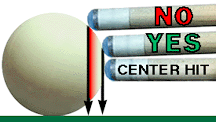

By Jim Meador
Follow should be the most frequently used shot in pool. It is certainly the easiest to learn and master. Follow is used, as the term implies, to make the cue ball follow the object ball for a controlled distance. It can also make the cue follow for an uncontrolled distance. I avoid using the term top spin (so far) because it might conjure up images of the ball spinning forward the way bottom (draw) makes the ball spin backward.
It is difficult, if not impossible, to put as much forward spin on the cue ball as back spin. When back spin is used, a point below center is struck, which decreases the balls weight and friction on the cloth. Top spin increases the weight and friction of the ball against the cloth by "trapping" the ball as shown in the diagram above. In the diagram, red indicates the danger zone. Beyond the danger zone lies a fire breathing dragon.
Trying to increase the amount of top spin by raising the contact point of the leather can have the opposite effect. Again, notice the diagram above. Hitting the cue ball higher than one cue tip above center also places the tip closer to the vertical line, above the point where the ball rests on the table, and traps the ball between the tip and table's surface. Higher yet, and the cue stick will ride over the ball, probably causing it to go nowhere. This is a common miscue.
I have seen players try to minimize the trapping action of a high hit on the cue ball by lowering the butt of the stick at the end of the stroke. I have also seen them miss the cue ball altogether trying this stunt. It works better in theory than practice. Advanced players can pull it off.
To follow for a short distance, a hit 1/4 cue tip above center, shot softly, will allow the friction of the table's surface to give the ball natural forward roll. Shooting hard can cause the cue ball to slide with no (appreciable) increase in spin.
For a more follow, raise the tip fractionally, and shoot a medium stroke. Again, shooting hard does not help, especially with a full (straight on) hit on an object ball that is close.
I wish I had a nickel for every time I have seen players (including myself) try to follow hard, with a full hit, from an object ball that is in the jaws of the pocket, in order get a strong cue ball rebound from the rail. More often than not, the cue ball dies on the rail. This is because the cue ball, upon contact with the object ball, stops dead before top spin causes it to roll forward again. If the distance to the rebound rail is too short, the cue ball can not gather enough forward momentum (energy) to bounce off the rail with any force. The top spin will simply take the ball back to the rail. It may leave and return to the rail several times before the top spin is exhausted. This dynamic is used by trick shooters to make the cue ball "jitter bug" along a rail to sink a second ball that was on the same rail as the first.
In a game, the anomaly can be cured by cutting the object ball thinner (cheat the pocket) with outside english, and going to two or three rails for position. Inside english can "kill" the ball off the rail if the shot is too thick.
When cutting the object ball, top spin can cause the cue ball's path to curve inward to reduce the natural carom (deflection) angle. This is valuable knowledge when a scratch threatens. Bottom english will increase the angle. Soft shots (top and bottom) maximize deflection angles by reducing the slide of the cue ball before the english takes effect.
Like every other shot, top spin should be practiced a lot, and tight control exercised over the hit. Top spin requires a level stick, since a downward stroke will exacerbate the problem of trapping the cue ball, or cause the cue ball to curve if hit just slightly off vertical center.
Happy Shooting! Jim & Pat